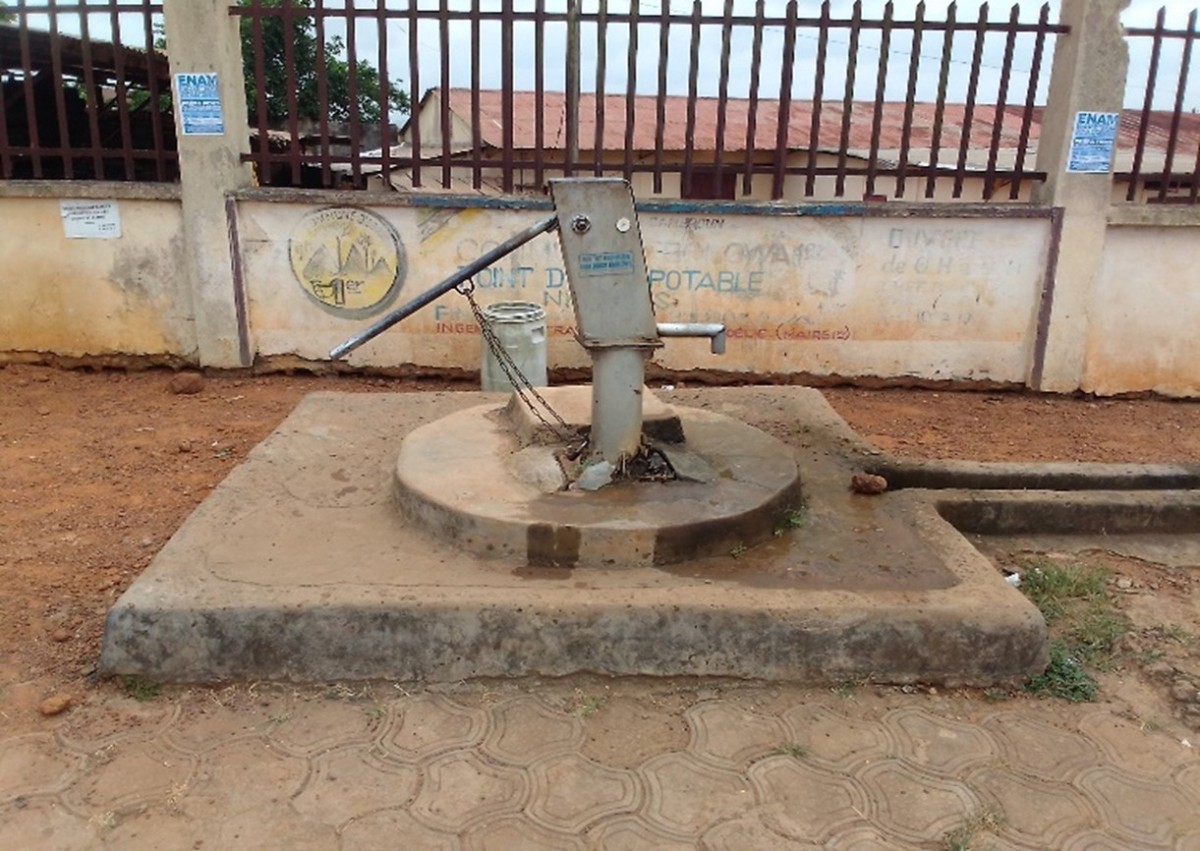By Victor Dang Mvongo, MSc, a PhD student at the University of Dschang (Cameroon) and an independent consultant in WASH. He conducted the work featured in this blog at the Faculty of Agronomy and Agricultural Sciences.
Handpumps, the most common rural water supply equipment in sub-Saharan Africa, are a symbol of the sustainability issue facing rural water services. According to Macarthur (2015), handpumps are a lifesaver for 184 million people living in rural sub-Saharan Africa. Sub-Saharan African statistics on handpumps’ functionality indicate that 36% of them are broken, with country-level rates varying from 10% to 65% (RWSN 2009).
In Cameroon, little data are available on the functionality of the handpump. However, Deal and Furey (2019) estimate that 32% of handpumps are non-functional. Thus, for the impacted rural areas, this means that the anticipated returns on investment—better health, nutrition, and education—are jeopardized. In order to mobilize the necessary national and international efforts in the region, this study intends to give local information on the functionality of handpumps in the Mvila Division (Southern Region of Cameroon).
The methodological approach was based on a technical inspection of 647 water points (181 boreholes and 466 wells) and semi-structured interviews with 500 stakeholders, including 103 water point committee members, 389 water users, and 8 water experts. The technical inspection was carried out in order to determine the functionality of the water points. Thus, if a handpump has been out of order for more than six months on the day of the technical inspection, it will be considered non-functional. Otherwise, it was considered functional.
According to our findings, one out of every three hand pumps is inoperable. Based on this rate, approximately 1.3 billion CFA francs (2 million USD) invested by the government, communities, and development partners are immobilized and do not generate any benefit for affected rural communities. At the national level, based on estimates of non-functionality from Foster et al. (2019), it is about 25 billion CFA francs (38 million USD) invested in the construction of water points which are immobilized. Figure 1 presents the spatial distribution of handpump in Mvila Division.
Furthermore, 29% of the handpumps show cracks on the lifting column and signs of corrosion. This high percentage of pumps showing signs of corrosion comes from handpumps made from unsuitable materials. Indeed, for several years, the Don Bosco Technical Institute in Ebolowa has been manufacturing handpumps locally (Figure 2). However, it has been found that some stainless steel parts are attacked by corrosion. This caused malfunctions that required major repairs only a few years after their construction. The same applies to imported handpumps, which generally do not comply with international standards for the composition of stainless steel. However, the extent of this phenomenon remains to be determined.

Figure 1. Spatial distribution of handpumps in Mvila Division (Source: Mvongo et al., 2023) 
Figure 2. Don Bosco handpump in Ebolowa (Source: Mvongo et al., 2023)
This high level of handpump non-functionality is due to the low economic viability of water point management, the poor functionality of water point committees, and the poorly structured handpump maintenance chain.
The financial flows generated by the contributions within the water point committees are very low and do not make it possible to cover all the repairs to the water points. This situation is exacerbated by the strong absence of a culture of selling water. Indeed, the principle of payment for water appears to be in opposition to the shared values of the peoples of the equatorial forest.
At the institutional level, the political context of decentralization does not yet favor better management of water services. Indeed, the state has transferred competences to the council without, however, making available to them the means (material, financial, and human) necessary to provide the water service.
At the managerial level, the main factor affecting the functionality of handpumps is the weak functionality of water point committees. Indeed, one WPC in four out of ten water points does not have a WPC in the area. From a technical point of view, the weak structuring of the handpump maintenance chain constitutes the main barrier to the functionality of the handpumps. Indeed, the lack of repair artisans and the absence of a spare parts sales outlet in the Mvila Division led to an increase in the duration and cost of repairs.
The pooling of water point management at the scale of the Mvila Division appears to be an avenue to be explored to improve the functionality of the handpump. This pooling of resources will allow the creation of an intermunicipal syndicate of municipalities in the Mvila Division, which is a divisional rural water supply company whose purpose is to ensure the management of rural water supply systems. Pooling the management of handpumps has been tested with promising initial results in the Center Region of Cameroon, where the councils of the Mbam and Inoubou divisions and those of the Lekié division have respectively set up Sycomi (the Union of Municipalities of Mbam and Inoubou Division) and Syncolek (the Union of Municipalities of Lekié Division).
Further reading:
Mvongo D.V, Defo C, Tchoffo M. (2023) Assessing the functionality of water supply handpumps in a Sub-Saharan Africa rural environment: a practical application in eight councils in the Mvila Division, Southern Cameroon. Journal of water, sanitation and Hygiene for development. https://doi.org/10.2166/washdev.2023.241
References:
Deal, P.T., Furey S.G. 2019 RWSN international directory of rural water supply models, tariffs and lifecycle costs, 2019 Edition, RWSN, Skat Foundation, St. Gallen, 44 p.
Foster, T., Furey, S., Banks, B. & Willets, J. 2019 Functionality of handpump water supplies: a review of data from sub-Saharan Africa and the Asia-Pacific region. International Journal of Water Resources Development 36 (5): 855–69. https://doi.org/10.1080/07900627.2018.1543117
Macarthur, J. 2015 Handpump Standardisation in Sub-Saharan Africa: Seeking a Champion. St. Gallen: Rural Water Supply Network.
RWSN 2009 Handpump data, selected countries in sub-Saharan Africa. RWSN, St Gallen, Suisse. https://www.ruralwater-supply.net/_ressources/documents/default/203.pdf

